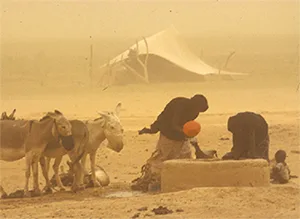FAO Released Report on Sand and Dust Storms(SDS)
FAO Released Report titled Sand and Dust Storms (SDS): A Guide to Mitigation, Adaptation, Policy, and Risk Management Measures in Agriculture.
In the report, Food and Agriculture Organization (FAO) highlighted that SDS frequency is consistent with climate change projections.
- It indicates the expansion of global drylands, increased aridity and worsening drought conditions.
What is Sand and Dust Storms (SDS) ?
SDS occurs when strong, turbulent winds erode small particles from dryland surfaces with little or no vegetation cover.
- 75% of global dust comes from natural sources and 25% from anthropogenic sources.
♦ Major anthropogenic factors responsible for SDS include land-use change, agriculture and deforestation.
Implications of SDS:
- Affects 11 of the 17 Sustainable development goals (SDG’s).
♦ For instance progress in SDG 6 (clean water and sanitation) is disrupted as dust depositions are compromising water quality. - Deposition of dust on glaciers induces a warming effect and increases the melting of ice.
- Reduces agricultural yield due to sandblasting (damage plants by impact, burial, and exposure of plant roots).
Recommendations:
- Sustainable land and water management.
- Structural stabilisation measurements through windbreaks, agroforestry and afforestation.
- Risk/impact assessment and vulnerability mapping.
- Strengthening of risk governance and increasing investment and financing in SDS risk reduction.
Initiative Taken to Mitigate SDS
Global
- UNCCD (United Nations Convention to Combat Desertification), 1994 (enforced in 1996).
- United Nations Coalition on Combating SDS launched at COP 14 of UNCCD (2019).
- Sand and Dust Storm Project by World Meteorological Organization (WMO).
India
- Aravalli Green Wall Project was launched to create buffer area around the Aravalli Hill Range.
- National Mission for Green India (NMGI) under National Action Plan on Climate Change (NAPCC).

